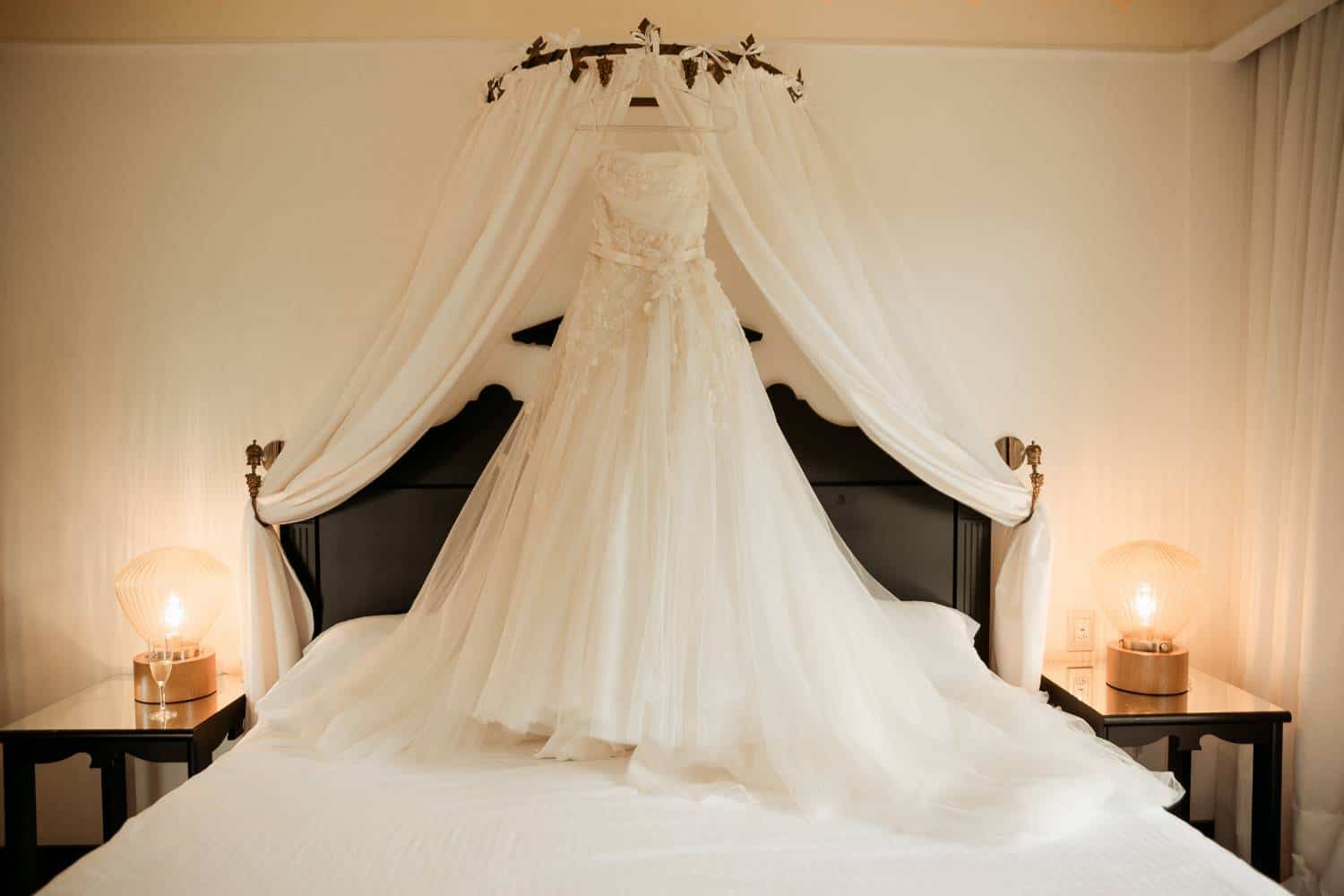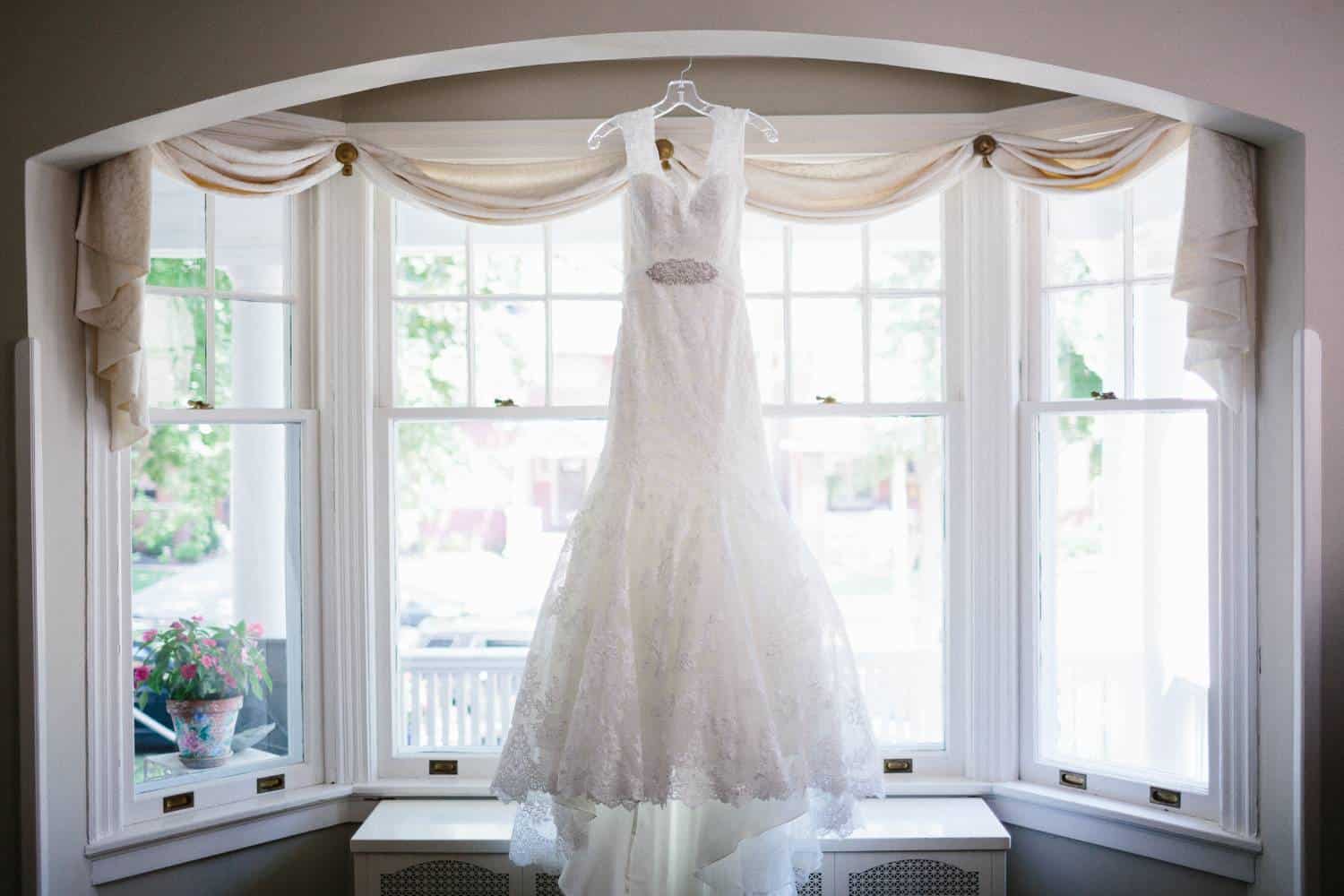After your wedding, your bridal gown may hold significant sentimental value, representing one of the most important days of your life.
Many brides hope to preserve their wedding dresses to pass them down to future generations.
However, wedding dresses can become yellowed over time if not properly cared for or stored.
This can be disappointing, but the good news is that yellowing is not necessarily permanent, and there are ways to prevent it as well as restore a discoloured dress.
In this guide, we’ll provide clear steps on how to prevent your wedding dress from yellowing and offer practical solutions for restoring it to its original colour if discolouration has already set in.
Let’s get straight to the point
To prevent a wedding dress from yellowing, it’s essential to have it professionally cleaned right after the wedding and store it properly in a cool, dry place, using acid-free and lignin-free materials.
Avoid plastic garment bags, exposure to light, and improper storage environments like attics or basements.
For dresses that have already yellowed, professional restoration services can often restore the original white colour, while DIY methods like soaking in mild detergent or using oxygen-based bleach may help, though they require caution.
Proper long-term care and storage are key to preserving the gown for future generations.
How to Prevent Wedding Dress Yellowing
Preventing yellowing begins with taking the right steps immediately after your wedding day.
Whether you’re planning to keep your dress as a memento or pass it down, preserving its pristine condition requires careful attention to storage and fabric care.
Here are the best ways to prevent your wedding dress from turning yellow.
1. Clean the Dress Immediately After the Wedding
The first step in preventing yellowing is to have your dress professionally cleaned as soon as possible after your wedding.
During the big day, your gown likely picked up various stains, even those you might not have noticed.
These can include sweat, makeup, perfume, grass, food, and drink spills. Over time, these stains can darken and lead to discolouration, which can cause yellowing.
Why It’s Important to Clean Immediately:
- Some stains are invisible at first but will oxidise and become yellow or brown with time.
- Immediate cleaning helps remove dirt and contaminants before they have a chance to set into the fabric.
Professional Cleaning:
- Hire a professional who specialises in wedding dress cleaning to ensure your gown is treated with care. They will use techniques that match your fabric type and address any specific stains without causing damage.
2. Store Your Dress Properly
Improper storage is one of the leading causes of yellowing in wedding dresses.
Simply hanging your dress in a closet or keeping it in the bag you brought it home in isn’t enough to protect it. To prevent yellowing, the storage environment and materials need to be carefully considered.
Proper Storage Steps:
- Use Acid-Free, Lignin-Free Materials:
Wrap your wedding dress in acid-free, lignin-free tissue paper. Acidic materials can cause fabrics to deteriorate and yellow over time. Lignin, found in wood products, breaks down and produces acid that can affect fabric quality. Make sure any storage boxes or tissue paper you use are free of these components. - Choose Breathable Garment Bags:
Avoid plastic garment bags, as they trap moisture, which can lead to yellowing. Instead, use a breathable cotton garment bag or a special preservation box designed for wedding gowns. - Avoid Metal Hangers:
Metal hangers can rust over time, which may transfer to your dress, causing stains. Instead, padded fabric hangers are used to hang the gown if necessary, but storing it flat in a preservation box is often the best option for long-term storage. - Control the Temperature and Humidity:
Store your dress in a cool, dry place, away from direct sunlight, which can cause discolouration. Attics and basements are not ideal storage locations due to the temperature fluctuations and humidity. Choose a space in your home where the temperature is controlled.
3. Avoid Long-Term Contact with Plastic
One of the common mistakes brides make is storing their wedding dresses in plastic bags, which are often provided when purchasing the gown.
While plastic bags can protect the dress during short-term transportation, they are not suitable for long-term storage.
Issues with Plastic Storage:
- Plastic bags trap moisture, leading to the growth of mildew and yellowing.
- Some plastics release harmful chemicals over time that can contribute to fabric discolouration.
Instead of plastic, opt for a preservation box made of acid-free materials or a breathable fabric garment bag.
4. Avoid Exposure to Light
Light exposure, particularly sunlight, is a major factor in causing fabrics to fade or yellow. Even indoor lighting can lead to gradual discolouration if a dress is exposed for extended periods.
How to Protect from Light:
- Store your dress in a dark, enclosed space, such as a closet or under a bed in a preservation box.
- Avoid displaying your dress in direct sunlight or near windows where sunlight can reach it.
5. Consider Professional Wedding Dress Preservation
For the best protection against yellowing, professional preservation is the most effective method.
Many bridal shops and specialised dry cleaners offer wedding dress preservation services that ensure your gown is cleaned, treated, and stored in the best possible way.
What to Expect from Preservation Services:
- Cleaning: A professional cleaner will remove all stains and contaminants that could lead to discolouration over time.
- Proper Packaging: The dress will be placed in an acid-free, lignin-free preservation box or bag.
- Sealing: Some preservation services seal the dress in an airtight package, which protects it from moisture and environmental pollutants. However, if you choose this option, remember that you won’t be able to open the box without breaking the seal.
How to Restore a Yellowed Wedding Dress
If your wedding dress has already yellowed, don’t panic. There are several methods available to help restore the gown to its original white colour.
While restoring a yellowed wedding dress can be a delicate process, many brides have successfully brought their dresses back to life using both professional services and DIY methods.
1. Professional Restoration Services
The most reliable way to restore a yellowed wedding dress is through professional cleaning and restoration.
Specialists in wedding dress preservation have the knowledge and tools to treat delicate fabrics without causing further damage.
They can effectively remove yellowing and restore your gown’s original brightness.
How the Process Works:
- Assessment: The preservation specialist will assess the fabric type and extent of yellowing to determine the best cleaning method.
- Cleaning: Using advanced techniques, they will carefully clean the dress, removing discolouration while protecting the integrity of the fabric and any embellishments.
- Whitening: For gowns with significant yellowing, professional cleaners may use safe whitening agents to restore the dress’s bright white colour.
This option is particularly recommended for gowns made of delicate fabrics like silk or dresses with intricate beading and lace that could be damaged by harsher cleaning methods.
2. Home Restoration Techniques
If professional restoration isn’t an option, there are a few home methods you can try to remove yellowing from your dress.
However, these should be approached with caution, as some fabrics are more sensitive to certain cleaning solutions.
DIY Cleaning Methods:
- Soaking in Mild Detergent
For non-silk dresses, try soaking the gown in a mixture of water and mild, fabric-safe detergent. Avoid scrubbing, as this can weaken the fibres. Let the dress soak for a few hours and rinse thoroughly. - Oxygen-Based Bleach
Oxygen-based bleach (like OxiClean) is a safer alternative to chlorine bleach, which can damage fabrics. Mix the product with water according to the instructions and soak your dress for several hours, checking regularly for progress. Rinse the gown thoroughly after soaking. - Spot Treatment with White Vinegar
For areas with more stubborn yellowing, a solution of white vinegar and water can be applied to the stained sections. Gently dab the solution on the yellowed spots, let it sit for a few minutes, and then rinse with water. - Sunlight Whitening (with Caution)
While sunlight can cause yellowing, it can also help whiten certain fabrics. After soaking your dress in an oxygen-based bleach solution, lay it out in a shady area where indirect sunlight can help brighten the fabric. Be cautious, as too much direct sunlight can further damage the dress.
3. Take Care with Delicate Fabrics
Restoring a yellowed silk wedding dress requires extra caution, as silk is much more delicate than synthetic fabrics.
Avoid harsh chemicals or scrubbing, as these can cause permanent damage. For silk dresses, it is always best to seek professional cleaning and restoration services.
4. Address Stubborn Stains
In addition to yellowing, you may find that other stains have appeared on your dress over time. These can be caused by food, drink, or makeup that wasn’t fully cleaned before the dress was stored.
Treating Stains:
- Body Oils and Sweat: These stains can be more difficult to remove and often require professional cleaning. Avoid using heavy-duty cleaners on delicate fabrics.
- Wine or Food Stains: Try spot-cleaning with a mild detergent or vinegar solution, but test the solution on a hidden area of the fabric first to ensure it doesn’t cause further discolouration.
Long-Term Care for Your Wedding Dress
Once your wedding dress has been restored, it’s essential to store it properly to prevent yellowing from happening again.
Ensure that the dress is cleaned thoroughly, stored in the correct materials, and kept in a stable environment with low humidity and minimal light exposure.
Conclusion
A yellowed wedding dress can be disappointing, but it is not the end of the road for your cherished gown.
By taking the right steps immediately after your wedding and investing in proper storage techniques, you can prevent yellowing from occurring.
If your dress has already turned yellow, professional restoration services or careful home remedies can bring it back to its former beauty.
Preserving your wedding dress allows you to keep the memories of your special day alive and, potentially, pass the gown down to future generations.
By following these guidelines, you can ensure that your wedding dress remains a beautiful keepsake for years to come.
Frequently Asked Questions
Can you fix a wedding dress that has yellowed?
You can restore your yellowed wedding gown by using a wedding dress preservation kit. This is one of the most modern and effective methods to restore this type of garment.
It is also a 100% safe and guaranteed method. The only thing you need to do is to find a reliable service provider to help you.
Will my wedding dress turn yellow before wedding?
The delicate fabrics in a wedding dress will begin to yellow after just six months if your dress is not cleaned, cared for, and stored properly after your wedding day.
Why has my wedding dress turned yellow?
Yellowing occurs when the original fibres of the fabric undergo chemical degradation due to quality problems with the textile.
The white and pastel fabrics eventually start decaying, giving the typical wedding dress a light-to-medium yellow colour.
Can you preserve a wedding dress years later?
While ideally, sooner is always better than later, the actual truth is that it really is never too late to have a wedding dress cleaned and preserved.
While it may not be possible to remove all stains, a restoration specialist can usually bring your beloved dress back to life more than you’d think possible.
Why do white dresses turn yellow?
Even white fabrics made from natural fibres like cotton and linen can turn yellow if they are exposed to too much chlorine bleach.
And, if you are using too much detergent or fabric softener and not rinsing well, the high heat of the clothes dryer can “bake” the residue into the fibres and leave them grey or yellow.



